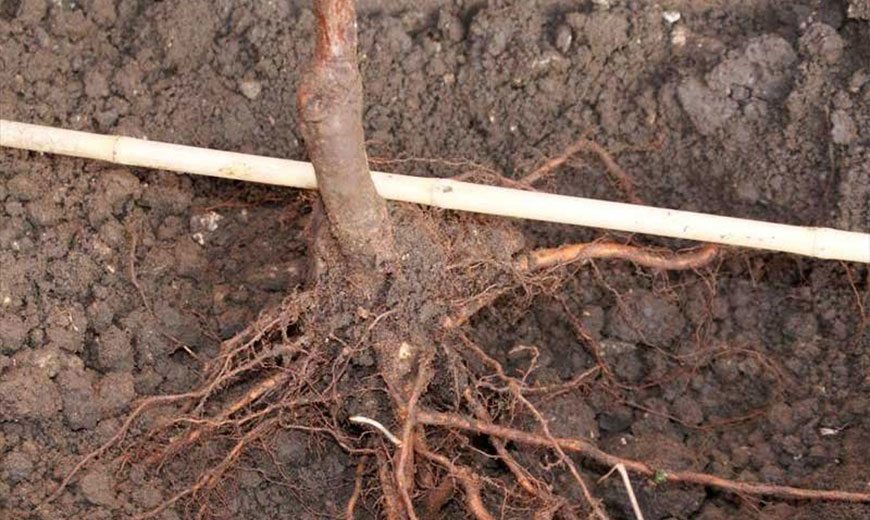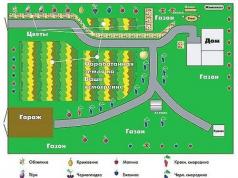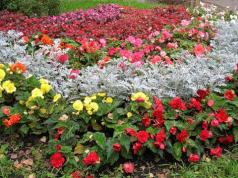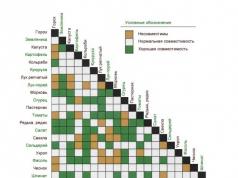Fruit garden you need to plan slowly, thinking everything over well, since the future harvest will depend, among other things, on the right place. For an orchard, you need to highlight a bright open area. It is undesirable to lay an orchard in a lowland, where water will accumulate after bad weather or spring melting of snow.
Start bookmark orchard it is necessary with inspection and preparatory work, which includes cleaning the site from old stumps, stones and other debris, digging up all the land on the site and analyzing the soil. Soil analysis will tell you what fertilization you should apply in the future. If you spill all the land on the site with water, this will provoke the growth of weeds for their subsequent removal.
The next step is planning a garden plot.
The location of the orchard can be influenced by the following data:
- Location relative to the house (in front of the house, behind the house, on the side of the house)
- About the cardinal points
- The presence of other garden areas on your site - flower beds, beds, reservoirs, lawn, etc.
Before you break orchard, you also need to decide what breeds and varieties will grow in it. Many trees reach maturity only after 7-10 years. In this case, the harvest will have to wait a long time. In case you do not want to wait, and you want to get the harvest next year, you can plant large-sized plants.
Large size - These are adult trees, aged 4 to 7 years, around the root system of which an earthen ball is formed. When transplanting such trees, as a rule, a special technique is used.
When choosing tree species, one must remember that many species do not like neighborhoods and suppress each other's growth. In addition, different trees in an orchard have completely different preferences for light and soil. It is advisable to consult with a specialist, or study the relevant literature.
Moreover, each culture has its own characteristics of the structure of the root system. For example, in an apple tree, the roots can grow in breadth up to 10 m, and in depth up to 6 m. The root system of a pear, on the contrary, grows more in depth - up to 10 m, and in breadth - up to 6 m.
If the soil in your garden is heavy, the tree will not be able to root deeply. Such a tree is likely to be weak.
Of course, it is difficult to find the ideal conditions in our orchards for each tree. But still, the basic rules for planting trees will help you establish a healthy fruit garden that delights with its harvest. In order for the tree not only to grow, but to bear fruit and be strong, it is necessary to provide it with an optimal layer of fertile soil, which will be the source of the necessary moisture and nutrition.

When planting large trees, your dream of turning the site into a blooming orchard quickly turns into reality. In addition, the root system of such trees is already practically formed, and they can be replanted without fear.
Modern technology allows transplanting mature trees ( fruit large-sized) without too much trouble.
Trees prepared for transplantation should naturally be healthy and free from damage. Trees with a hollow are not suitable for replanting.
The crown of a large fruit must be significantly thinned out (remove some skeletal branches by about 1/3 of their length) in order to avoid moisture evaporation. Cover the wounds formed after pruning with garden varnish.
The soil ball should be cubic or cylindrical.
The pit is prepared in advance (1-2 weeks in advance). Its dimensions should exceed the earthen lump (twice - in height, and three times - in width).
The bottom is being prepared - a mixture of expanded clay is poured, then humus, sand, peat and black soil. The percentage of this mixture depends on the wood species.
After planting a large-sized tree, all the free space in the pit is covered with good fertile soil. Then, it is slightly compacted.
And, of course, they are well watered. Moreover, an irrigation system is provided (aeration tube or root watering).
Additional reinforcement with guy wires will help stabilize the transplanted tree.

It is necessary to choose young plants (1-2 years old). So they take root better. The root system of older seedlings is easier to damage.
Saplings for an orchard usually planted in autumn or spring at rest (when vegetative processes are slowed down).
When planting seedlings, a hole is dug in advance (approximately 80x80 cm) and filled with fertile soil. The soil from the depth of the pit can be distributed around the trunk circle. If the seedling is planted immediately after digging a hole, the soil at the bottom must be compacted - tamp it down with your feet and pour 1-2 buckets of water.
Also, organic fertilizers (compost, manure) and mineral fertilizers are introduced into the planting pit. The amount of fertilizer for each tree species is different. It is better not to add mineral fertilizers directly to the roots of the plant. Only the ground from the top layer.

When landing seedlings for the orchard broken branches must be removed. The roots are pruned (to a healthy part) only if they are damaged.
A healthy seedling should have a well-branched root system. If the roots are dry along the way, they can be placed in water for about 12-24 hours. Immediately before planting, it is advisable to dip the roots in a clay mash.
If planting is not possible for several days, the seedling should be wrapped with a damp cloth and several layers of newspaper.
Leaves, in order to avoid moisture evaporation, it is better to carefully remove.
When planting, it is advisable to take into account the position of the seedling relative to the cardinal points. For 1-2 years, while they were growing in the nursery, they adapted to certain light conditions. The south side of the stem of the seedling can be distinguished by its darker brown color. The lighter side is the north.
Do not deepen the root collar! It should be at ground level. After planting, the soil near the trunk circle is mulched, and the seedling itself is tied to a peg (not tight, eight).
The main seedlings for orchard- these are pears, cherries and plums.








